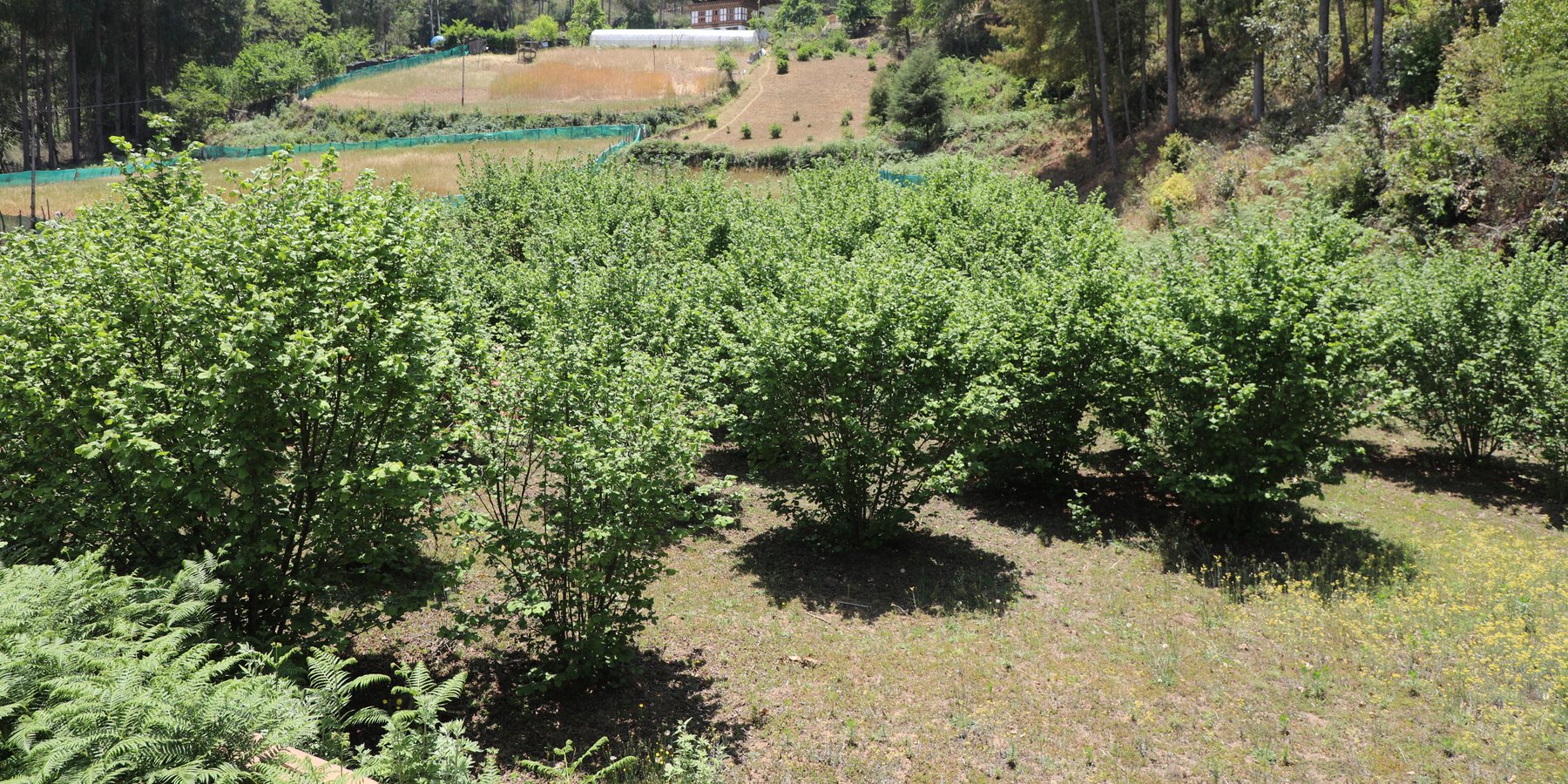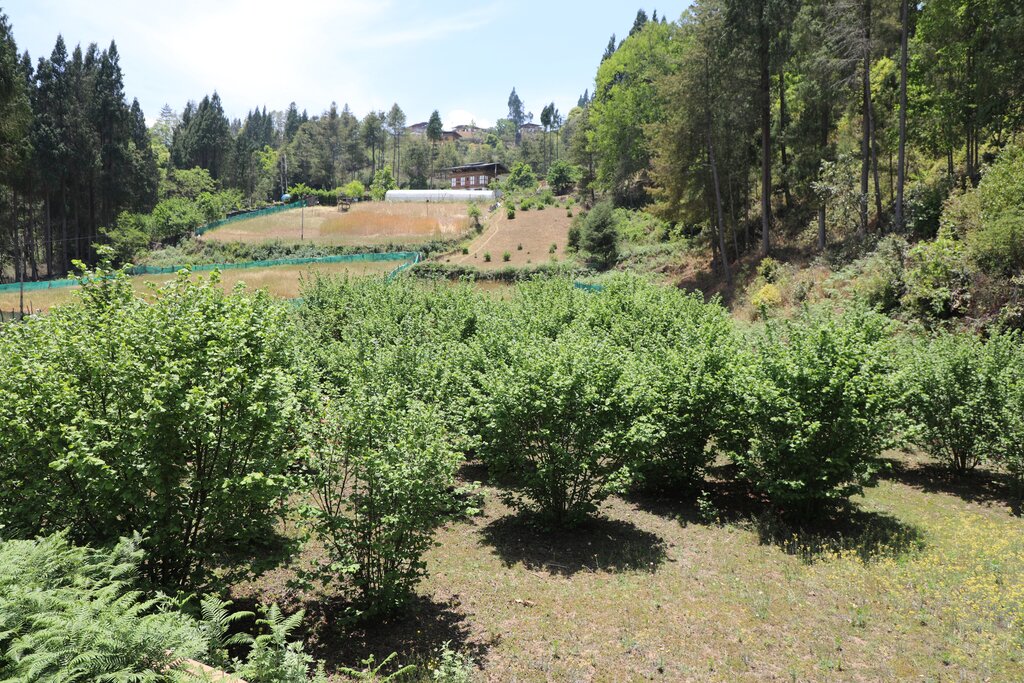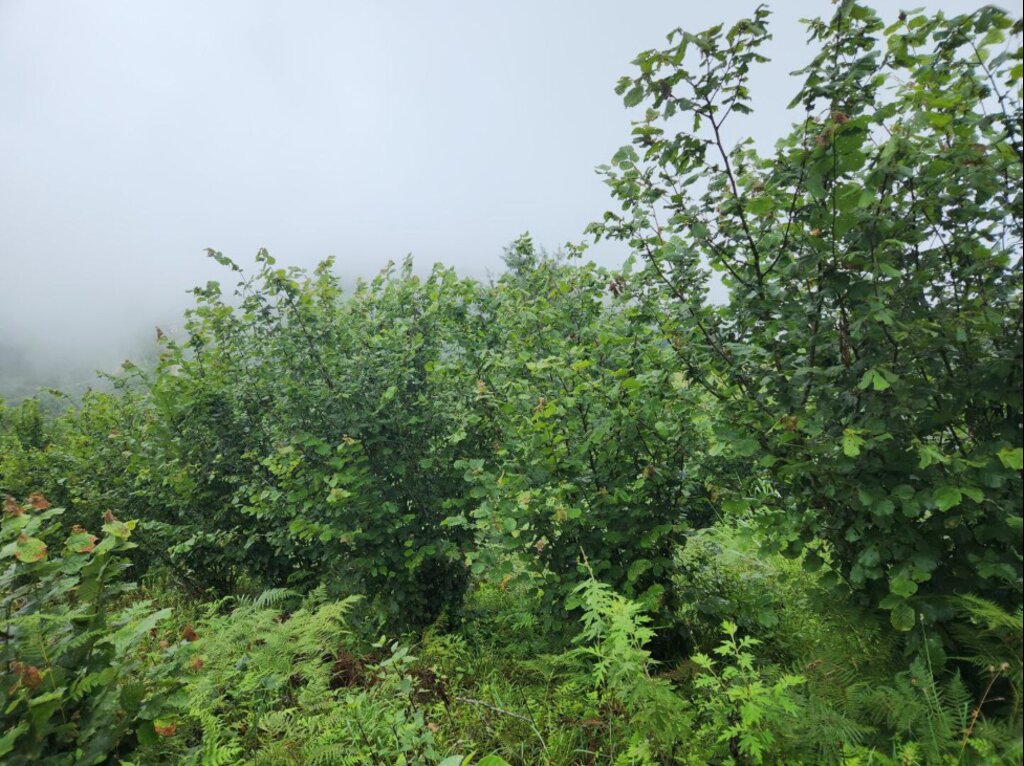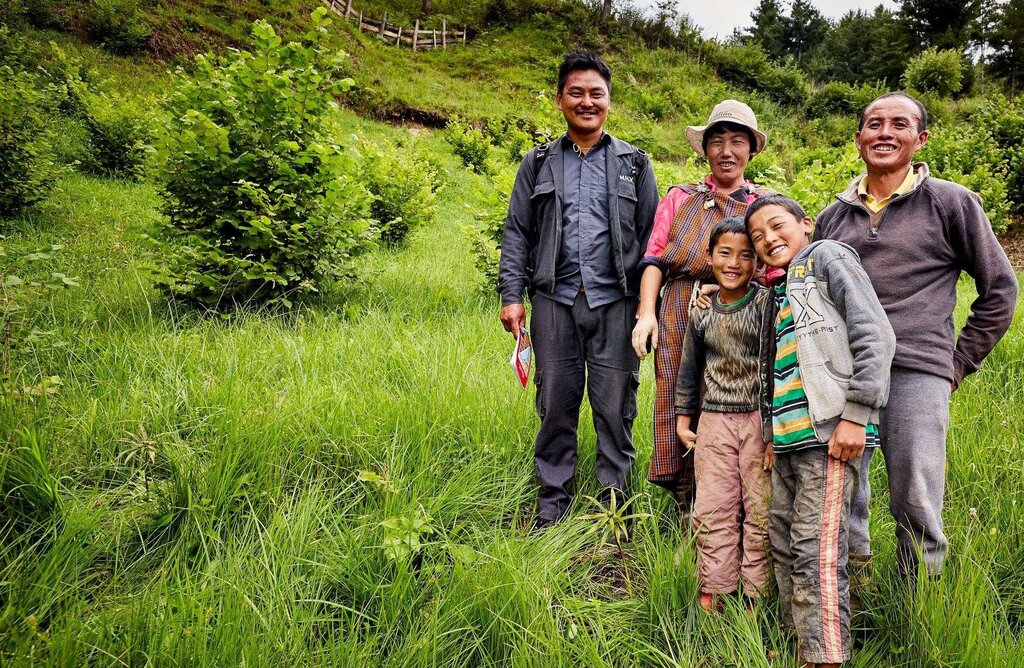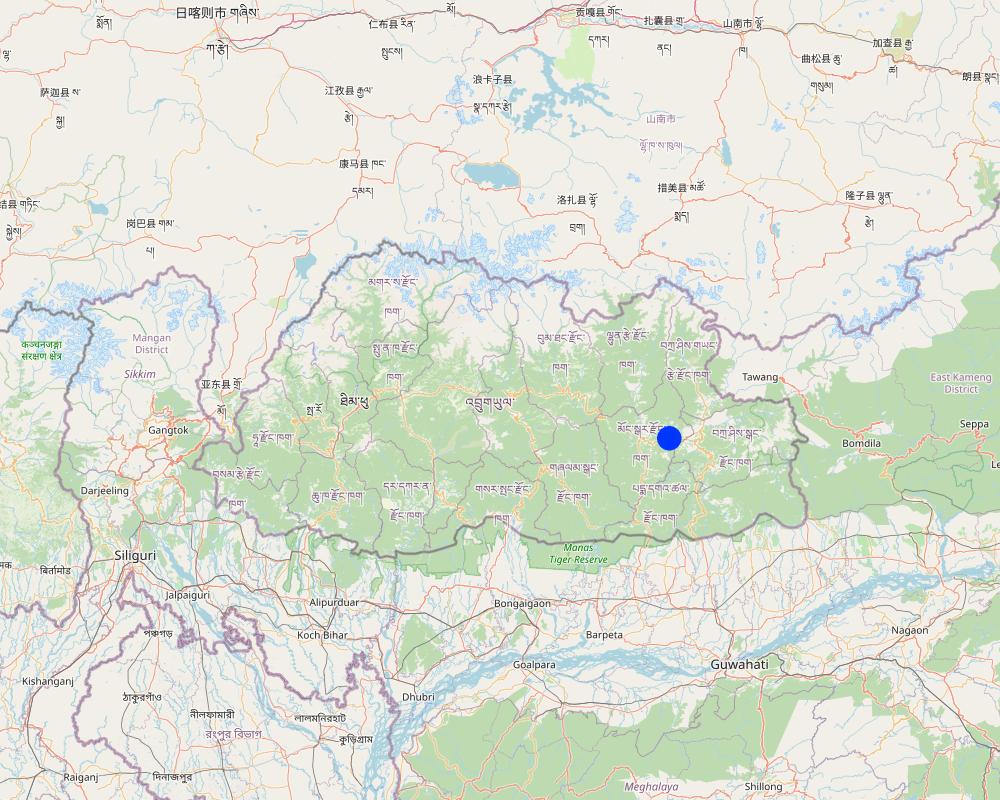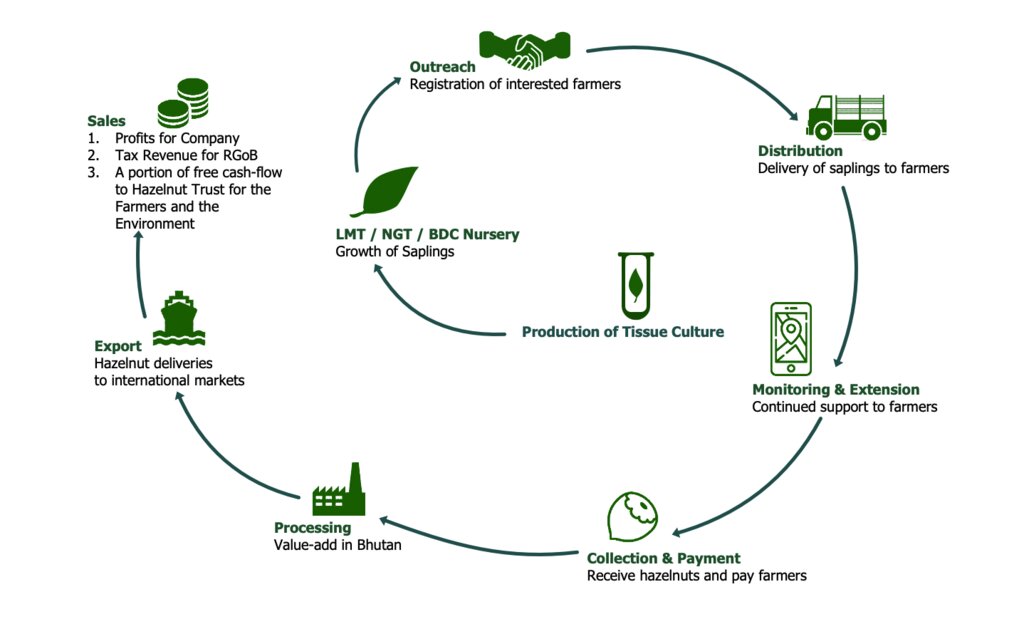Public-Private-Community Partnership for Land Degradation Neutrality [ภูฏาน]
- ผู้สร้างสรรค์:
- การอัพเดท:
- ผู้รวบรวม: ONGPO LEPCHA
- ผู้เรียบเรียง: Kuenzang Nima
- ผู้ตรวจสอบ: William Critchley, Rima Mekdaschi Studer, Joana Eichenberger
Zhung Ger dang Midhey Thuendrel Thok Sazhi Dhakzin Thabthang (གཞུང་ སྒེར་དང་མི་སྡེ་མཐུན་འབྲེལ་ཐོག་ས་གཞི་བདག་འཛིན་འཐབ་ཐངས།)
approaches_6843 - ภูฏาน
ดูส่วนย่อย
ขยายทั้งหมด ย่อทั้งหมด1. ข้อมูลทั่วไป
1.2 รายละเอียดที่ติดต่อได้ของผู้รวบรวมและองค์กรที่เกี่ยวข้องในการประเมินและการจัดเตรียมทำเอกสารของแนวทาง
วิทยากรหลัก
ผู้ใช้ที่ดิน:
Tenzin Karma
+975 77675442
Domlung village
Domlung village, Ngatshang gewog (block), Mongar Dzongkhag (district), Bhutan
ภูฏาน
ผู้ใช้ที่ดิน:
Penjor Tshewang
+97517544223
Domlung village
Domlung village, Ngatshang gewog (block), Mongar Dzongkhag (district), Bhutan
ภูฏาน
ผู้ใช้ที่ดิน:
Wangmo Yeshey
+97517680522
Domlung village
Domlung village, Ngatshang gewog (block), Mongar Dzongkhag (district), Bhutan
ภูฏาน
ผู้ใช้ที่ดิน:
Lhamo Ngawang
Domlung village
Domlung village, Ngatshang gewog (block), Mongar Dzongkhag (district), Bhutan
ภูฏาน
ชื่อของโครงการซึ่งอำนวยความสะดวกในการทำเอกสารหรือการประเมินแนวทาง (ถ้าเกี่ยวข้อง)
Strengthening national-level institutional and professional capacities of country Parties towards enhanced UNCCD monitoring and reporting – GEF 7 EA Umbrella II (GEF 7 UNCCD Enabling Activities_Umbrella II)1.3 เงื่อนไขที่เกี่ยวข้องกับการใช้ข้อมูลที่ได้บันทึกไว้ผ่านทาง WOCAT
วันที่เก็บรวบรวมข้อมูล (ภาคสนาม):
13/07/2023
ผู้รวบรวมและวิทยากรหลักยอมรับเงื่อนไขเกี่ยวกับการใช้ข้อมูลที่ถูกบันทึกผ่านทาง WOCAT:
ใช่
2. คำอธิบายของแนวทาง SLM
2.1 การอธิบายแบบสั้น ๆ ของแนวทาง
The public-private-community partnerships (PPCP) approach is a synergistically operational model that is used to achieve sustainable development in which the three parties jointly develop a business unit/service of mutual benefit and provide maximum benefit to the wider community. This approach is designed to enable economically disabled households and community organizations to generate long-term benefits through sustainable agriculture - in this case hazelnut production.
2.2 การอธิบายอย่างละเอียดของแนวทาง
การอธิบายอย่างละเอียดของแนวทาง:
The Mountain Hazelnut Venture (MHV) is a social enterprise established as a Public-Private-Community Partnership (PPCP) between the people and the Royal Government of Bhutan and a private company. The PPCP approach involves private entity funding of a project, and it has become common countrywide, The MHV has enabled a large-scale Foreign Direct Investment (FDI) project. The MHV provides hazelnut trees, agricultural inputs, and technical assistance to smallholder farmers. At harvest, the company purchases hazelnuts from partner growers, which are then processed for international export. The primary objective of this approach is to foster collaboration between the private company and the community to generate long-term income and revitalize vulnerable communities through sustainable agriculture. Hazelnut orchards stabilize mountain slopes, reduce soil erosion, improve water retention, and help adapt to, and mitigate, climate change by improving ground cover, retaining soil moisture and sequestering carbon.
The private company looks for interested farmers who are then registered. The company propagates good quality hazelnut seedlings and distributes them. This is followed up by constant monitoring by technical staff until fruits are harvested and processed. The implementation stage includes planning, providing them with necessary agricultural inputs, and technical support through extension and monitoring. Once the fruits are harvested, payment is made to the farmers. Implementation involves the MHV engaging with community members alongside agricultural extension agents to present and convince them about the benefits of the project. Additionally, the MHV provides training, workshops, and ongoing support. They finance the project while also taking on the role of monitoring and evaluating its outcomes.
There are three key stakeholders involved in this approach. They are the community members (landowners), the Royal Government of Bhutan, and the Mountain Hazelnut company. It is reported that there are more than 8,000 smallholder land users registered with MHV from 19 of 20 districts in Bhutan. The roles of the land users are to grow hazelnuts through nurturing the seedlings, harvesting the nuts, and selling them to the Hazelnut company as per the mutual agreement. Land users are provided free seedlings, consistent technical and field support, and the guaranteed buyback of nuts by the company. They also received training and assistance. The second key stakeholder is the Royal Government, who provides clearance and facilitates the establishment of business in line with the national Foreign Direct Investment (FDI) Policy. In the field, agriculture extension agents represent the government by facilitating communication between the hazelnut company and the communities. Lastly, the MHV as a private company is committed to fostering the development of entrepreneurs in the agribusiness sector across Bhutan.
The advantages of the approach to the land users are the financial, technical and material support provided by the private company. The land users can also develop their skills and knowledge through training on hazelnut cultivation and good agricultural practices (GAP). Hazelnut is a new crop in the locality.
Finally, the company is committed to generating income and improving the livelihood of rural communities in Bhutan. However, despite the noble objectives, the company has failed to realize its intended target, and this is an increasing cause of concern. Furthermore, there are complaints that the harvests have been poor – or even zero in some cases. It is clear that there had been inadequate investigation into the viability of hazelnuts in Bhutan. While failing on the economic front so far, from the land degradation neutrality (LDN) point of view, the hazelnut plantations have improved ground cover immensely thereby generating environmental benefits through stabilization of vulnerable agricultural land, reduction in land degradation and carbon sequestration.
2.3 รูปภาพของแนวทาง
2.5 ประเทศ ภูมิภาค หรือสถานที่ตั้งที่ได้นำแนวทางไปใช้
ประเทศ:
ภูฏาน
ภูมิภาค/รัฐ/จังหวัด: :
Mongar Dzongkhag
ข้อมูลเฉพาะเพิ่มเติมของสถานที่ตั้ง:
Domlung village, Ngatshang gewog
Map
×2.6 วันที่เริ่มต้นและสิ้นสุดของแนวทาง
ระบุปีที่เริ่ม:
2011
ความคิดเห็น:
The approach is currently in the monitoring and evaluation phase since the Hazelnut trees in Domlung village have not fruited even once as like most other orchards in the country.
2.7 ประเภทของแนวทาง
- ใช้โครงงานหรือแผนงานเป็นฐาน
2.8 เป้าหมายหรือวัตถุประสงค์หลักของแนวทาง
The primary objective of this approach is to persuade the community to embrace the Mountain Hazelnut Venture and foster collaboration between the private company and the community to advance the project, generate long-term income, revitalise vulnerable communities through sustainable agriculture, stabilising mountain slopes, reducing erosion, improving water retention, and mitigating climate change by improving soil fertility and carbon sequestration.
2.9 เงื่อนไขที่เอื้ออำนวยหรือเป็นอุปสรรคต่อการนำเทคโนโลยีภายใต้แนวทางนี้ไปปฏิบัติใช้
บรรทัดฐานและค่านิยมทางสังคม วัฒนธรรม ศาสนา
- เอื้ออำนวย
Because land users are from same ethnic group, they shared similar culture and traditional. There were no objection from other land users on implementing the technology.
การมีไว้ให้หรือการเข้าถึงแหล่งการเงินและบริการ
- เอื้ออำนวย
The project is fully funded by a private company, meaning the company provides all the planting materials and inputs with regard to it; very minimal cost goes into the project by the land users.
การร่วมมือหรือการทำงานประสานกันของผู้ลงมือปฏิบัติ
- เอื้ออำนวย
Officials from the private company often visit the community to monitor and evaluate the progress of the project, and has played a significant role in providing the community members with all the skills and knowledge with regard to hazelnut cultivation.
ความรู้เกี่ยวกับ SLM การเข้าถึงการสนับสนุนด้านเทคนิค
- เอื้ออำนวย
The land users were trained on good agricultural practices (GAP) for hazelnut cultivation and proper land management practices before implementing the project.
ตลาด (จัดซื้อปัจจัยนำเข้า ขายผลิตภัณฑ์) และราคา
- เป็นอุปสรรค
Despite the guaranteed buyback by the company, the land users could not harvets any hazelnuts as there is no fruiting yet.
ปริมาณงานที่ทำได้ กำลังคนที่มีให้
- เอื้ออำนวย
Hazelnuts are fairly easy to grow and not much care is required. Hence not much of labour is required.
3. การมีส่วนร่วมและบทบาทของผู้มีส่วนได้ส่วนเสียที่เกี่ยวข้อง
3.1 ผู้มีส่วนได้ส่วนเสียที่เกี่ยวข้องในแนวทางนี้และบทบาท
- ผู้ใช้ที่ดินระดับท้องถิ่นหรือชุมชนระดับท้องถิ่น
Domlung community members (land users)
The roles of the Interested land users are to grow hazelnut saplings on their land, nurture these seedlings, harvest the nuts, and sell them to the Hazelnut company.
- ภาคเอกชน
Mountain Hazelnut Venture
It is committed to fostering the development of entrepreneurs in the agribusiness sector across Bhutan. It provides farmers with seedlings, and agricultural inputs such as fertilizers and extension services, and also buys the nuts from the land users. Apart from this Mountain Hazelnuts is committed to fostering the development of entrepreneurs in the agribusiness sector across Bhutan.
- รัฐบาลแห่งชาติ (ผู้วางแผน ผู้ทำการตัดสินใจ)
Ministry of Agriculture and Livestock of the Royal Government of Bhutan
Provided clearance and facilitaed business establishment as per the Foreign Direct Investment (FDI) Policy.
- Extension agent
Ngatshang gewog (block) Agriculture Extension Agent
Facilitated communication between the private company and the communities.
3.2 การเกี่ยวข้องของผู้ใช้ที่ดินระดับท้องถิ่นหรือชุมชนระดับท้องถิ่นในช่วงต่างๆของแนวทาง
| ความเกี่ยวข้องของผู้ใช้ที่ดินระดับท้องถิ่นหรือชุมชนระดับท้องถิ่น | ระบุผู้ที่มีส่วนเกี่ยวข้องและอธิบายกิจกรรม | |
|---|---|---|
| การริเริ่มหรือการจูงใจ | ปฏิสัมพันธ์ | The land users were sensitized on the Mountain Hazelnut Venture, in particular the long term benefits of improving income and livelihoods. Mutual agreements were signed between the company and the land users. |
| การวางแผน | ไม่ลงมือ | The private company (MHV) decide on the timeline of the project and how to implement it. However, the community members and the extension agents are informed about the plan. |
| การดำเนินการ | ระดมกำลังด้วยตนเอง | For the implementation, land users were equipped with all the skills and materials required for the projects success. They plant and cultivate the hazelnut in their fields on their own, with some assistance from the company's field coordinator. |
| การติดตามตรวจสอบหรือการประเมินผล | ปฏิสัมพันธ์ | Officials from the company (MHV) visits the land users field together with the land users, where the hazelnuts were cultivated and checks the progress of the project. |
3.3 แผนผังแสดงขั้นตอนการทำงาน (ถ้ามี)
คำอธิบาย:
The flow chart of the approach was adopted from Mountain Hazelnut Venture (MHV) website
ผู้เขียน:
Mountain Hazelnut Venture website (https://www.mountainhazelnuts.com/)
3.4 การตัดสินใจเลือกใช้เทคโนโลยี SLM
ระบุผู้ที่ทำการตัดสินใจเลือกเทคโนโลยีมากกว่าหนึ่งวิธีไปปฏิบัติใช้:
- Private sector (MHV)
การอธิบาย:
The decision to implement the project in Domlung was done by the private company (MHV) based on their findings and agreement by the community.
ระบุว่าการตัดสินใจตั้งอยู่บนพื้นฐานของ:
- การประเมินความรู้ SLM ที่ได้ทำการบันทึกไว้เป็นอย่างดี (การใช้ข้อมูลในการตัดสินใจ)
4. การสนับสนุนด้านเทคนิค การสร้างขีดความสามารถ และการจัดการด้านความรู้
4.1 การสร้างขีดความสามารถ / การอบรม
ได้มีการจัดอบรมให้แก่ผู้ใช้ที่ดินหรือผู้มีส่วนได้ส่วนเสียคนอื่น ๆ หรือไม่:
ใช่
ให้ระบุว่าใครเป็นผู้ได้รับการอบรม:
- ผู้ใช้ที่ดิน
รูปแบบการอบรม:
- เกษตรกรกับเกษตรกร
- ใช้พื้นที่ทำการสาธิต
- จัดการประชุมสู่สาธารณชน
หัวข้อที่พูด:
The subjects covered included the cultivation of hazelnuts, good agricultural practices, proper land and agronomic management of hazelnuts, grafting, weed control, and sustainable land management.
ความคิดเห็น:
The capacity building was financed by the private company and was supervised by the agricultural extension agent.
4.2 การบริการให้คำแนะนำ
ผู้ใช้ที่ดินมีการเข้าถึงการรับบริการให้คำปรึกษาหรือไม่:
ใช่
ระบุว่ามีบริการให้คำปรึกษาหรือไม่:
- ไปเยี่ยมชมสถานที่
- Private company
การอธิบาย/แสดงความคิดเห็น:
Advisory services were provided by the field coordinator and other officials from the private company (MHV).
4.3 การเสริมความแข็งแกร่งให้กับสถาบัน (การพัฒนาองค์กร)
สถาบันได้รับการจัดตั้งขึ้นมาหรือเสริมความแข็งแกร่งโดยแนวทางนี้หรือไม่:
- ไม่
4.4 การติดตามตรวจสอบและประเมินผล
การติดตามตรวจสอบและประเมินผลเป็นส่วนหนึ่งของแนวทางหรือไม่:
ใช่
ความคิดเห็น:
In accordance with the land users of Domlung, officials from the private company visits the village sporadically to check the progress of the project.
ถ้าตอบว่าใช่ แสดงว่าการจัดเตรียมเอกสารนี้มุ่งหวังที่จะเอาไปใช้สำหรับการติดตามตรวจสอบและประเมินผลใช่หรือไม่:
ไม่ใช่
4.5 การวิจัย
การวิจัยเป็นส่วนหนึ่งของแนวทางหรือไม่:
ไม่ใช่
5. การสนับสนุนด้านการเงินและวัสดุอุปกรณ์
5.1 ระบุงบประมาณประจำปีสำหรับแนวทาง SLM นี้
ระบุงบประมาณประจำปีสำหรับแนวทาง SLM นี้ เป็นหน่วยดอลลาร์สหรัฐ:
30000000.00
แสดงความคิดเห็น (แหล่งของการระดมทุน ผู้บริจาคคนสำคัญ):
Mountain Hazelnut Venture (The annual budget is the total investment of the company for the entire project)
5.2 การสนับสนุนด้านการเงิน / วัสดุอุปกรณ์ให้แก่ผู้ใช้ที่ดิน
ผู้ใช้ที่ดินได้รับการสนับสนุนด้านการเงิน / วัสดุอุปกรณ์ไปปฏิบัติใช้เทคโนโลยีหรือไม่:
ใช่
ถ้าใช่ ให้ระบุประเภทของการสนับสนุน เงื่อนไขและผู้จัดหามาให้:
The financial support was received in the form of planting materials and other materials such as fencing.
5.3 เงินสนับสนุนสำหรับปัจจัยนำเข้า (รวมถึงแรงงาน)
- อุปกรณ์
| ระบุปัจจัยนำเข้าที่ได้รับการสนับสนุน | เห็นด้วยระดับไหน | ระบุเงินสนับสนุน |
|---|---|---|
| Nets | ได้รับการช่วยเหลือทางการเงินแบบเต็ม | Green nets |
- การเกษตร
| ระบุปัจจัยนำเข้าที่ได้รับการสนับสนุน | เห็นด้วยระดับไหน | ระบุเงินสนับสนุน |
|---|---|---|
| เมล็ด | ได้รับการช่วยเหลือทางการเงินแบบเต็ม | Hazelnut saplings were provided to the land users for free of cost. |
| ปุ๋ย | ได้รับการช่วยเหลือทางการเงินบางส่วน | Fertilizers are bought at 50% of its original price by the land users. |
ถ้าแรงงานโดยผู้ใช้ที่ดินเป็นปัจจัยนำเข้าที่มีอยู่มากมาย ระบุด้วยว่าเนื่องจาก:
- ให้ค่าตอบแทนด้วยการสนับสนุนด้านวัสดุอุปกรณ์อื่น ๆ
5.4 เครดิต
มีการจัดหาเครดิตมาให้ภายใต้แนวทาง SLM หรือไม่:
ไม่ใช่
5.5 แรงจูงใจหรือเครื่องมืออื่น ๆ
แรงจูงใจหรือเครื่องมืออื่น ๆ ได้ถูกนำไปใช้ส่งเสริมการใช้เทคโนโลยี SLM หรือไม่:
ไม่ใช่
6. การวิเคราะห์ผลกระทบและการสรุป
6.1 ผลกระทบของแนวทาง
ช่วยให้ผู้ใช้ที่ดินนำเอาเทคโนโลยี SLMไปใช้และบำรุงรักษาสภาพไว้ได้หรือไม่:
- ไม่ใช่
- ใช่ เล็กน้อย
- ใช่ ปานกลาง
- ใช่ อย่างมาก
Almost all the farming households in Domlung have cultivated hazelnuts. They were trained on how to manage land and they also reported the benefits of growing trees besides harvesting the nuts.
ระดมกำลังหรือปรับปรุงการเข้าถึงแหล่ง เงินทุนสำหรับการดำเนินการ SLM หรือไม่:
- ไม่ใช่
- ใช่ เล็กน้อย
- ใช่ ปานกลาง
- ใช่ อย่างมาก
There was no improvement in access to financial resources, but the land users have been supported financially for the project through provisin of inputs either free or on cost sharing basis.
ปรับปรุงความรู้และความสามารถของผู้ใช้ที่ดินในการดำเนินการ SLM หรือไม่:
- ไม่ใช่
- ใช่ เล็กน้อย
- ใช่ ปานกลาง
- ใช่ อย่างมาก
All the land users in Domlung village have attended several trainings and workshops before the project implementation. Some of this training included SLM intervention topics like Terrace making, stone bund walls, and growing hazelnuts in erosion-prone areas.
ทำให้ผู้ใช้ที่ดินระดับท้องถิ่นมีอำนาจขึ้น ปรับปรุงการเข้าร่วมของผู้มีส่วนได้ส่วนเสียให้ดีขึ้นหรือไม่:
- ไม่ใช่
- ใช่ เล็กน้อย
- ใช่ ปานกลาง
- ใช่ อย่างมาก
The approach involves three main stakeholders i.e., land users, extension officers of the Royal Government and the private company. The approach has strengthened collaboration between stakeholders, i.e., land users and extension, extension and private company, etc.
ทำให้กลุ่มด้อยโอกาสมีอำนาจทางสังคมและเศรษฐกิจหรือไม่:
- ไม่ใช่
- ใช่ เล็กน้อย
- ใช่ ปานกลาง
- ใช่ อย่างมาก
All the land users were engaged as stakeholders and were equally benefited.
ปรับปรุงความทัดเทียมกันด้านเพศและให้อำนาจแก่ผู้หญิงและเด็กผู้หญิงหรือไม่:
- ไม่ใช่
- ใช่ เล็กน้อย
- ใช่ ปานกลาง
- ใช่ อย่างมาก
The approach allowed both men and women to participate. Thus gender equality was well taken care. It is also one of the company's objectives to ensure that women comprise approximately half of MH staff at all levels, from community lead growers through the executive team.
ส่งเสริมให้เยาวชนหรือบุตรหลานของผู้ใช้ที่ดินให้เข้าร่วมใน SLM:
- ไม่ใช่
- ใช่ เล็กน้อย
- ใช่ ปานกลาง
- ใช่ อย่างมาก
Young land users of the community were the ones who showed more interest to the project.
นำไปสู่ความมั่นคงด้านอาหารหรือปรับปรุงโภชนาการให้ดีขึ้น:
- ไม่ใช่
- ใช่ เล็กน้อย
- ใช่ ปานกลาง
- ใช่ อย่างมาก
Although the land was cleared for planting hazelnuts, there were problems with pollination and variety resulting no fruiting. As a result land users turned hopeless without any income.
ปรับปรุงการเข้าถึงตลาดหรือไม่:
- ไม่ใช่
- ใช่ เล็กน้อย
- ใช่ ปานกลาง
- ใช่ อย่างมาก
Access to the market was assured through the project. However, there was no nut production.
ปรับปรุงความสามารถของผู้ใช้ที่ดินในการปรับตัวให้เข้ากับการเปลี่ยนแปลงของสภาพภูมิอากาศหรือสภาพที่รุนแรงและภัยพิบัติหรือไม่:
- ไม่ใช่
- ใช่ เล็กน้อย
- ใช่ ปานกลาง
- ใช่ อย่างมาก
Hazelnut plantation improved ground cover thereby enabling carbon sequestration and soil organic matter.
นำไปสู่โอกาสในการจ้างงาน รายได้หรือไม่:
- ไม่ใช่
- ใช่ เล็กน้อย
- ใช่ ปานกลาง
- ใช่ อย่างมาก
Individuals from outside the community were able to work for the private company in the last few years.
Contribution ot Land Degradation Neutrality (LDN):
- ไม่ใช่
- ใช่ เล็กน้อย
- ใช่ ปานกลาง
- ใช่ อย่างมาก
Although the MHV project failed to fully realize its main economic objective of income generation, the hazelnut plantation did improve ground cover and helped avoid, reduce and restore degraded land. It thus contributed towards achieveing voluntary Land Degradation Target (LDN) target set by the Royal Government of Bhutan.
6.2 แรงจูงใจหลักของผู้ใช้ที่ดินเพื่อที่จะนำ SLM ไปปฏิบัติใช้
- การผลิตที่เพิ่มขึ้น
The main motivation was to increase the production by growing hazelnut in marginal land. However, due to pollination and variety issues there was no production.
- กำไร (ความสามารถ) อัตราส่วนค่าใช้จ่ายต่อผลประโยชน์ที่เพิ่มขึ้น
With assured market, the company's main objective was to enable sustainable source of income for farmer and increase profitability. Even during the implementation process most of the costs were borne by the project thus giving less financial burden to the land users.
- การเสื่อมของที่ดินลดลง
Although the land users did not see direct relation between hazelnut plantation and land degradation, after the training provided by the company, they did realize that the hazelnut plantation can help reduce land degradation through improved ground cover.
- ภาระงานลดลง
Hazelnuts are hardy plants (adaptable) and fairly easy to grow and manage as compared to other economic crops like vegetables and cereals. This gives some leisure time to the land users.
- ความรู้และทักษะ SLM ที่เพิ่มพูนขึ้น
Before Hazelnuts plantation, land remained barren and exposed to different factors of land degradation. However, with hazelnut plantation, the lands are covered from direct sun and rain thereby preventing land degradation. Many land users shared that they didn't have this idea/knowledge before.
6.3 ความยั่งยืนของกิจกรรมของแนวทาง
ผู้ใช้ที่ดินสามารถทำให้สิ่งต่างๆ ที่ได้ปฏิบัติใช้โดยแนวทางนี้ยั่งยืนได้หรือไม่ (โดยไม่มีการสนับสนุนจากภายนอก):
- ไม่
ถ้าตอบว่าไม่หรือไม่แน่ใจ ให้ระบุและแสดงความคิดเห็น :
The land users who agreed to grow hazelnuts were the ones who were economically disabled. They could have sustained what was implemented through the approach if everything had gone as planned. However, there has been almost zero production of the hazelnuts from almost all hazelnut growing areas which has seriously affected the income. It has been almost 12 years since the first implementation of the project. Land users mentioned that they are now looking for other alternatives so that they can uproot hazelnuts and replace them with some other productive crop.
6.4 จุดแข็งและข้อได้เปรียบของแนวทาง
| จุดแข็ง / ข้อได้เปรียบของแนวทางในทัศนคติของผู้ใช้ที่ดิน |
|---|
| Support from the company: Easy for the land users to implement the project due to material and technical supports from the approach. Land users received inputs like hazelnut seedlings at the beginning, which was for free. They also received support for growing the seedlings, Taking care of the seedlings, etc., |
| Assured market: Land users also mentioned that the main motivation to get involved in such an approach was the market and the possibility of generating income. The company was willing to buy whatever quantity of hazelnuts they could produce from their land. |
| Capacity development: In addition to the support (agricultural inputs), the land users also received various training through which they were exposed to other technologies which some of them were totally unaware. They could enhance their skills and knowledge on hazelnut production like orchard cultivation, hazelnut value-chain, including processing and the provision of goods and services. |
| จุดแข็ง / ข้อได้เปรียบของแนวทางในทัศนคติของผู้รวบรวมหรือวิทยากรหลัก |
|---|
| Opportunities to economically disabled land users: One of the primary objectives of Mountain Hazelnut Venture is to enable smallholder farming households to generate long-term income, revitalize vulnerable communities through sustainable agriculture. Through this approach many youths were given employment as a worker in the project sites. |
| Focus on sustainable land management: The approach made land uesres to grow hazelnuts sapling in their marginal or unproductive land. When hazelnuts is fully grown, hazelnut plantations stabilize mountain slopes, reduce soil erosion, improve water retention, and mitigate climate change by improving soil fertility and carbon sequestration. In brief, hazelnut plantation as a SLM intervention, contributes to the realization of the land degradation neutrality (LDN) target and adapt to and mitigate climate change. |
6.5 จุดอ่อน / ข้อเสียเปรียบของแนวทางและวิธีในการแก้ไข
| จุดอ่อน / ข้อเสียเปรียบในทัศนคติของผู้ใช้ที่ดิน | สามารถแก้ไขปัญหาได้อย่างไร |
|---|---|
| No transparency of the information: Land users shared that they were lured by some officals saying the approach to be very profitable. They didn't explained them very well on positive and negative long term impact of the project. They didnt know about the plant (hazelnuts), Its problem in fruiting, etc., | This type of project is maily implemented for the welfare of the community. It should never be implemented for sole benefit of the company. |
| จุดอ่อน / ข้อเสียเปรียบในทัศนคติของผู้รวบรวมหรือวิทยากรหลัก | สามารถแก้ไขปัญหาได้อย่างไร |
|---|---|
| No proper planning and research: The main reason why this hazelnut planations failed in many places in Bhutan could be due to lack of proper planning and research. Given the wide range of elevation and climatic conditions in Bhutan, more adaptability or suitability trials at different elevations could have been conducted. | Suitability trials of different varieties of hazelnuts could have been done so that the best performing varieties and management practices could have been promoted to the land users on large scale. |
| No risk management: It appears like the MHV initiated its business with full confidnce that the project will do well in Bhutan and as such no risk management plans were in place. For instance, land users sacrificed most of their land with the hope of generating good income, but this didn't happen in reality. Many land users were left devasted and hopeless without any compensation from the company. | Any project should account the risk and accordingly provision risk management plan in the proposal and agreement. Such provisions should also be made transparent to all the parties so that it becomes very clear about the compensation should the project fail. |
7. การอ้างอิงและการเชื่อมต่อ
7.1 วิธีการหรือแหล่งข้อมูล
- ไปเยี่ยมชมภาคสนาม การสำรวจพื้นที่ภาคสนาม
One household
- การสัมภาษณ์กับผู้ใช้ที่ดิน
Four individuals
7.2 การอ้างอิงถึงสิ่งตีพิมพ์
ชื่อเรื่อง ผู้เขียน ปี ISBN:
Asian Development Bank. (n.d.). Public-Private Partnership Handbook. ADB.
ช่องทางในการสืบค้น และราคา:
https://www.adb.org/sites/default/files/institutional-document/31484/public-private-partnership.pdf
ชื่อเรื่อง ผู้เขียน ปี ISBN:
Perez, M. C. (2015). Public-Private-Community-Partnerships for Renewable Energy Cooperatives. Wegeningen UR.
ช่องทางในการสืบค้น และราคา:
https://edepot.wur.nl/337095
7.3 เชื่อมโยงกับข้อมูลที่มีอยู่บนออนไลน์
ชื่อเรื่องหรือคำอธิบาย:
Mountain Hazelnut Venture
URL:
https://www.mountainhazelnuts.com/
ชื่อเรื่องหรือคำอธิบาย:
Public–Private–Community Partnership
URL:
https://penabulufoundation.org/en/public-private-community-partnership/
ลิงก์และโมดูล
ขยายทั้งหมด ย่อทั้งหมดลิงก์
ไม่มีลิงก์
โมดูล
ไม่มีโมดูล


